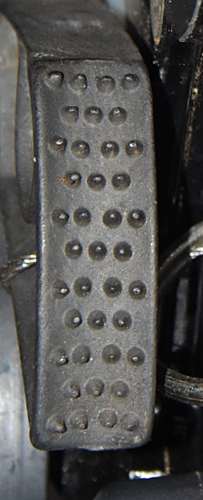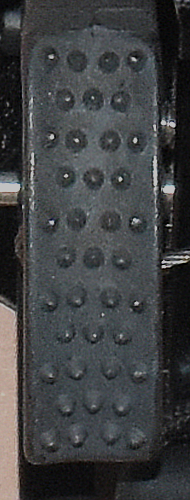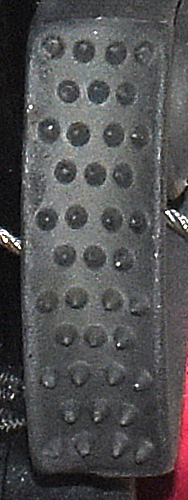Overview
[ Top
| Version B
| Version C
| Return to H.E.C. Ascenders
]
Version A
(#1934, 1940)
Technical Details
I acquired my first CMI Expedition Twin, Version A from Troy Kossick in 2012. That one was missing the quick-release (QR) pin safety, so I acquired a second from Alex Zimmerman in 2013.
Version A is 208 mm. tall, 106 mm. wide,
and 51 mm. thick. Mine weighs 409 g. It consists of a standard right-hand
CMI Expedition ascender with cut-off left-hand ascender attached to the rear by two countersunk head socket screws. The following gray text describes the standard right-hand ascender:
 The ascender shell is a roughly "D"
shaped piece of painted 4.2 mm. thick aluminum bent to form
a rope groove on one side and to hold the cam pivot and safety
on the other. The handle opening is 106 mm. high and 55 mm.
wide. There is a two-piece plastic hand grip bolted to the shell
with three 4.6 mm. cap screws and hex nuts. The left rear and right
front hand grips have round recesses for the cap screws, and hex
nuts fit into hexagonal recesses molded into the left front and
right rear hand pieces. Two 15.9 mm. holes at the base of
the shell serves as rope attachment points. A third 15.9 mm.
hole provides a means to attach non-load-bearing slings to the
shell above the cam.
The ascender shell is a roughly "D"
shaped piece of painted 4.2 mm. thick aluminum bent to form
a rope groove on one side and to hold the cam pivot and safety
on the other. The handle opening is 106 mm. high and 55 mm.
wide. There is a two-piece plastic hand grip bolted to the shell
with three 4.6 mm. cap screws and hex nuts. The left rear and right
front hand grips have round recesses for the cap screws, and hex
nuts fit into hexagonal recesses molded into the left front and
right rear hand pieces. Two 15.9 mm. holes at the base of
the shell serves as rope attachment points. A third 15.9 mm.
hole provides a means to attach non-load-bearing slings to the
shell above the cam.
Each cam is a skeletonized steel casting.
The conical teeth are oriented perpendicular to the cam face and
are set in a (4.3)^3(4) pattern. The inner cam face radius reduces
from top to bottom to accommodate various sized ropes. The cam
and cam spring are mounted on a solid 6.3 mm. steel pin.
An external retaining ring holds the pin in place. The cam safety
is a plastic lever mounted on a 3 mm. semi-tubular rivet in the same
shell channel as the cam. A second spring serves as a safety spring.
Normally this spring holds the safety where it blocks the cam
from opening. When the end of the safety lever is depressed, the
opposite end pivots upwards so that the cam is no longer obstructed. A 1.25 mm. stranded stainless steel cable connects the two cams, and a 25 mm. split ring on this cable serves as a finger tab for simultaneously opening the cams. A push-type quick-release pin fits in a 6.6 mm. hole drilled below the cam. When inserted, it prevents opening the cam far enough to easily remove the rope. A three-piece flange on the pin prevents removing the pin unless one depresses the thumb safety on the side of the ascender that the pin is inserted from.
One side of the ascender is printed with "Cmi," "EXPTWIN," and "MBS 3300 lbs 14 kN."
Although the split ring allows one to simultaneously open the cams, this only works part way, since there is no provision for simultaneously releasing both safeties with the same hand. I find it awkward trying to rig the ascender on two ropes at once; using both hands and rigging one rope at a time works better for me.
The QR pin safety adds additional hassle. It could serve a useful function in a working environment where one may not be paying attention to one’s ascenders, but cavers and climbers are not usually in this situation (although there are times…).
I think that the interference between the pin flange and the cam safety may be a manufacturing tolerance problem rather than a design feature.
The pin flange looks like it is made from three pieces that could not possibly hold together; clearly, this is an illusion. The pieces fit into a groove turned in the pin, and the holding mechanism is hidden.
I don't consider this ascender as the most suitable choice
suitable for mainstream caving (but perhaps some frogger might
choose it) or climbing, so what is it good for? I think it was
designed for the arborist community, and I'm not a Tarzan, so
it would not be right for me to discuss their techniques. Maybe
the arborists will discuss it on one of their web sites.
[ Top
| Version A
| Version C
| Return to H.E.C. Ascenders
]
Version B
(#3439)
 Technical Details
Technical Details
I acquired my CMI Expedition Twin, Version B from CMI in 2021.
Version B is 208 mm. tall, 104 mm. wide, 62 mm. thick, and weighs 437 g. The rope channel is 17 mm. wide. The pivot is centered 53 mm. from the inside of the rope channel. The cam radius increases from 41 to 57 mm. over an angle of 42°, giving a 25° cam angle. The tooth pattern is (4.3)^5(4).
Version B is identical to Version A except the flange on the QR pin now clears the cam safeties.
One side of the ascender is printed with "Cmi," "EXPTWIN," and "MBS 3300 lbs 14 kN."
I think that the interference between the pin flange and the cam safety on Version A was a manufacturing tolerance problem rather than a design feature. Version B corrects this.
[ Top
| Version A
| Version B
| Return to H.E.C. Ascenders
]
Version C
(#3439)
 Technical Details
Technical Details
I acquired my CMI Expedition Twin, Version B from CMI in 2021.
Version B is 208 mm. tall, 104 mm. wide, 62 mm. thick, and weighs 437 g. The rope channel is 17 mm. wide. The pivot is centered 53 mm. from the inside of the rope channel. The cam radius increases from 41 to 57 mm. over an angle of 42°, giving a 25° cam angle. The tooth pattern is (4.3)^5(4).
Version B makes two changes to Version A. First, the flange on the QR pin is smaller and no longer serves any function. Second, the safety is made of anodized aluminum instead of plastic.
One side of the ascender is printed with "Cmi," "EXPTWIN," and "MBS 3300 lbs 14 kN."
I like the aluminum safeties, although I see nothing wrong with the older plastic safeties.
[ Top
| Version A
| Version B
| Version C
]


